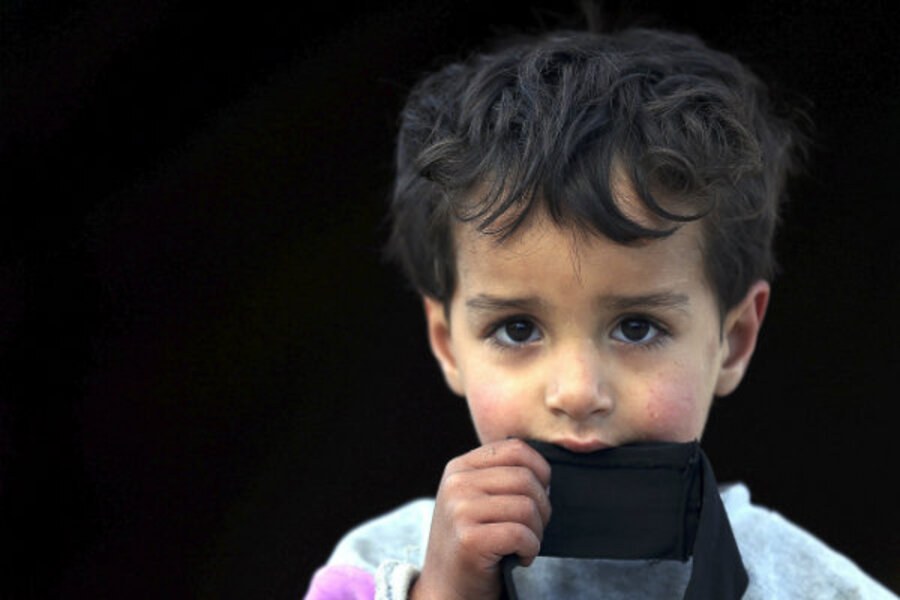For regional stability, help Syria's internally displaced
Loading...
| Washington
More than a quarter of Syria’s population – 5.75 million people – have been displaced in the country’s two-year civil war. Media coverage, UN debates, and diplomatic interventions have focused largely on the implications of the refugee crisis for the stability of neighboring countries – particularly Jordan and Lebanon, which are now each sheltering approximately 475,000 Syrians. Less attention has been paid to what the UN General Assembly recently called the “very dire situation” of the more than 4.25 million Syrians uprooted within their own country.
They are Syria’s internally displaced – forced from their homes, living within a war-torn country, with no place to go, often struggling to meet their basic needs for food, shelter, and medical care. This crisis demands increased attention.
A recent humanitarian assessment of the ravaged governorates of northern Syria concluded that the internally displaced consistently rank as the population group most at risk of abuse and deprivation. Increased protection and assistance for the internally displaced is also essential to managing the refugee crisis, and maintaining regional stability.
Before they fled to neighboring states, hundreds of thousands of Syrian refugees were first displaced within their own country. Many internally displaced Syrians fled their country and became refugees due to violence and fear of attacks. Others who might have chosen to remain in Syria were forced to seek shelter abroad because of inadequate access to food, medical care, water, sanitation, and schools within their own country.
Why would anyone remain in a country where children are starving to death, and bread lines are bombed? Some Syrians have little choice, as they lack a safe escape route, or the resources to flee abroad.
Others, particularly those who have found shelter in relatively stable areas, may remain to care for family members unable to travel far, to continue working, or to watch over assets such as livestock or businesses. While humanitarian action cannot halt the bloodshed in Syria, increased assistance could make the option of staying in Syria more plausible for those who wish – or have – to do so.
For example, an estimated 30,000 doctors have now left Syria. The group Refugees International reports that some doctors displaced from northern Syria say they wanted to stay in the region to provide urgently needed care, but with their salaries no longer being paid, they have had to move to Turkey in order to provide for their families.
Some, working with aid groups founded by refugees and diaspora members, slip back across the border into Syria to care for the sick and wounded. With humanitarian agencies indicating that access to health care is the most severe need in northern Syria, this is a critical contribution. Supporting and expanding such health-care initiatives may make it more viable for those who wish to remain in Syria to do so, lessening the pressure on refugee-hosting states.
Of course, seeking refuge abroad must remain an option for all Syrians who need it. Increased international assistance within Syria is no substitute for asylum, and cannot compensate for the lack of physical security for those living within the country. At most, humanitarian aid for the internally displaced may modestly ease the demand for refuge across borders.
As Jordan’s refugee camps become hotbeds of discontent and a last, worst resort for desperate Syrians, increased support for the internally displaced may give over-stretched host communities and neighboring governments alike some more room to maneuver.
Undoubtedly, increasing assistance to the internally displaced is easier said than done. The Syrian government has imposed crippling restrictions on the movement of humanitarian actors. And the delivery of aid, particularly across borders, remains incredibly risky, as medical workers and other humanitarian actors have been subject to attacks. But with increased support, the courageous humanitarian groups working in Syria could do more for those in need within the country.
The UN reports that its last humanitarian response plan for assistance inside Syria, covering the period of January-June 2013, was only 66 percent funded. Earlier this month, the UN’s top humanitarian officials launched the next phase of its assistance program for Syria. In addition to more robust assistance for refugee-hosting communities, strengthened support for internally displaced persons should be a central plank of the implementation of this plan. And this UN plan should be fully and promptly funded.
Unfortunately, the UN will likely continue to face massive obstacles accessing rebel held areas. These obstacles include persistent insecurity and almost impenetrable red tape imposed by the Assad regime to restrict the movement of aid convoys, particularly to rebel-held areas the government wants to starve of support. Increased support is therefore needed for the Syrian Arab Red Crescent Society and for the nongovernmental organizations and emerging diaspora groups that are providing vital assistance to those in rebel-held territories starved of help by the government.
Given the restrictions “traditional” humanitarian actors face in Syria, ways to support the innovative efforts of Syrians inside the country and in the diaspora must be identified. Ultimately, an improved response to Syria’s 4.25 million internally displaced persons requires not only money, but better access for humanitarian actors, and increased security for the displaced and their neighbors.
Only a political solution to the conflict can defuse Syria’s displacement crisis. Yet these steps would improve conditions for those who have fled their homes but cannot or prefer not to flee their country. At the same time they would relieve some of the pressure on refugee-hosting countries whose tremendous hospitality is coming closer to the breaking point with the arrival of every family that has no choice but to leave Syria.
Megan Bradley is a fellow in foreign policy at the Brookings Institution.





